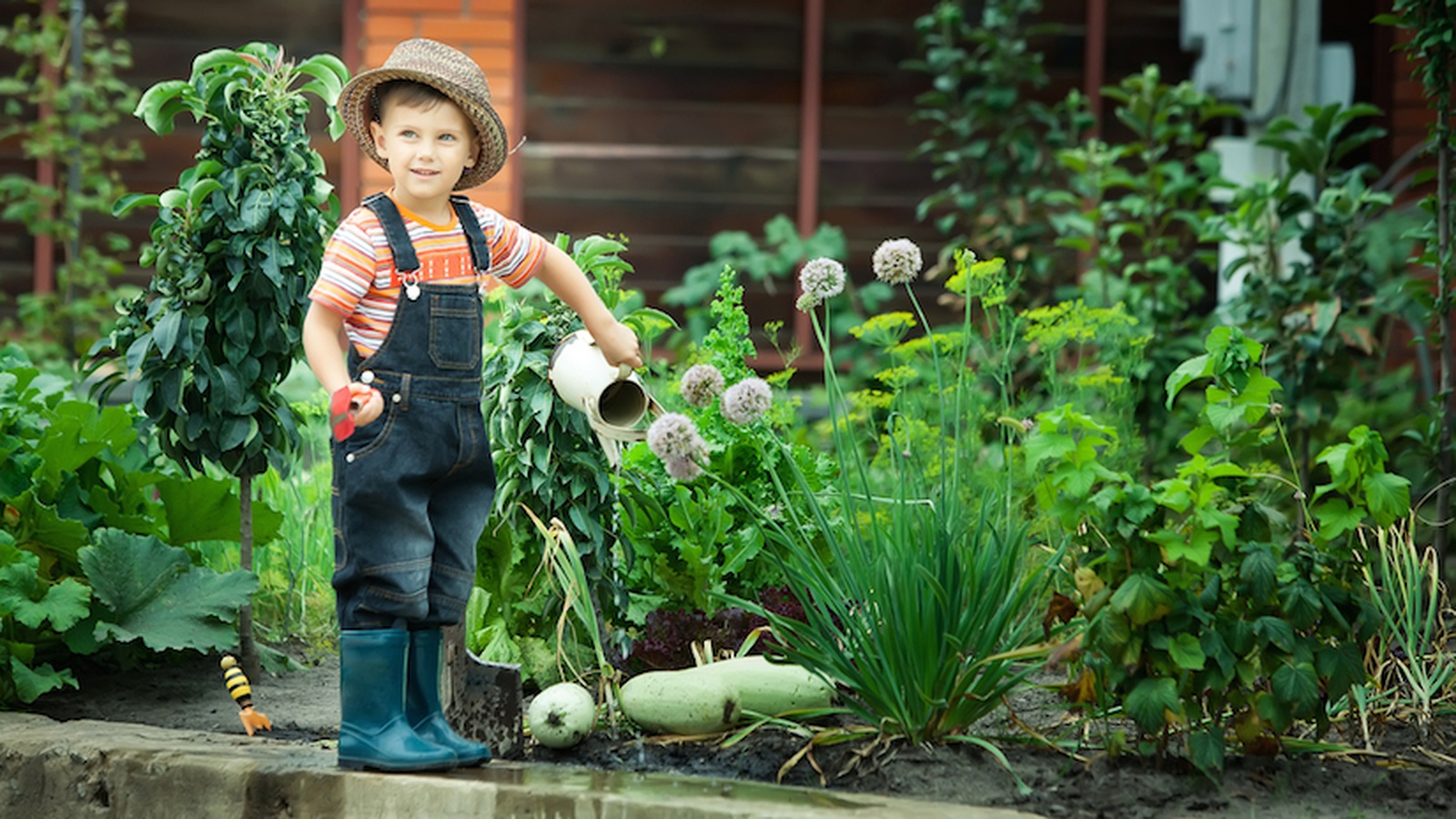How To Get Your Kids In The Garden
Confession: When I was a little girl, I used to sneak into the garden and eat all the carrots—and I mean all of them. It was no secret who did it: I was only about 4, and I'd leave the telltale carrot tops lying around as evidence of my consumption. My mother would lecture me about sharing, but I now know—as a mother myself—that she was really glowing with satisfaction. What mama wouldn't want her child to "sneak" for carrots instead of a Twinkie or cupcake?
In this age of iPods, cell phones, and the Wii, many parents feel it's nearly impossible to get their children excited about the outdoors—and we won't even talk about their lack of enthusiasm for veggies. But kids are interested in nature—they (and we parents, too) just might be too over stimulated to notice.
Younger kids are naturally drawn to the dirt, essentially creating mud baths whenever the opportunity arises. Older children might not be as into getting dirty, but they definitely are interested in receiving rewards for their work (um, allowance anyone?), and nothing is quite as rewarding as growing your own food.
Build It And They Will Come
The first step to luring your children outside is building a garden that suits their needs as well as yours. Gardens can be built anywhere, from conventional garden boxes and planters to a kiddy pool, old sandbox, or even an old claw-foot bathtub. City dwellers take note: Gardens can be created entirely in containers as long as the containers are suited to each individual plant. Once you've decided what you're going to plant your goods in and where (pick a sunny spot that receives at least six hours of sunshine per day), you'll want to figure out how much you need and want to plant in that space. If you have a small garden, that's going to be your guide. If you have a larger space, honestly evaluate how much your family can eat, give away, or preserve. The Family Kitchen Garden (Timber Press, 2009) offers a guide for figuring out exactly how much you need for a family of four. (Unfortunately, I read this guide much too late and have already started 60 tomato plants. I guess I'm going to be getting into the ketchup business.)
Little feet need paths to walk on, creating boundaries so they don't trample their hard work. The rule of thumb is to make the paths at least a few feet wide so that you can kneel and work in the garden space. (Or, so that a good game of tag won't ruin a month's worth of dedication and growth.) After your space is created, talk with a local gardener or read a local gardening guide to ensure that you have healthy soil and know which amendments to add for your region. Most kids aren't interested in manual labour, so it's best to work the soil before bringing your kids into the mix—no matter their age. Remember, you want this to be an adventure, not a punishment or a chore.
If you have more than one child, divide the garden, giving each gardener his or her own space for planting. Seeds do not have to be planted in rows. Let your children be creative, planting in a pattern that suits them. This will create a very organic looking space, full of wonder for everyone involved. (Do try to keep seeds the recommended distance from one another to allow them to succeed.)
Gardening Through the Ages
It is never too early to start gardening with children. Mike Metallo, president of the National Gardening Association, suggests introducing children as young as preschoolers to gardening. Toddlers and preschoolers have a natural propensity to explore. Depending on the age of your children, you'll want to gear your garden, and the resulting activities, toward their interests. Kids of all ages will enjoy watering as well as harvesting the produce. Older kids can be responsible for weeding and cleaning up the garden. Here are a few ideas for getting kids of all ages interested in your garden:
Globalize. Research different cultures and plant staples from those cultures, like basil from Italy, peppers or corn from Mexico, and eggplant from the Middle East. This will introduce your children to world cuisine, while also giving you the opportunity to bring a bit of diversity to your table.
Create a theme. A pizza garden or an herbal tea garden lets your kids have an endgame in mind throughout the process. Let the kids decide what constitutes a pizza topping (and don't forget herbs). If your 4-year-old is convinced that peas are a good choice, go with it. Gardens are meant to be creative, and sometimes a bit outlandish.
Celebrate the ecosystem. Younger kids are fascinated with creepy crawlers, so take advantage of that. Have them count the bugs and worms, and then take the opportunity to explain that many bugs are good for their plants, and that we want to do things to encourage them to visit, like, you know, not squishing them.
Keep track. Elementary school kids like to see results, so help them chart their plants' growth. If they've planted several tomato plants, for instance, have them measure each in terms of height as well as production, and help watch how they grow throughout the season.
Harvest as an appetizer. Kids of all ages will enjoy the task of picking dinner. Send them outside an hour or two before mealtime, asking them to choose fruits or veggies that are ripe that they'd like to have. Feeling adventurous? Ask for their input on how to weave the ingredients into a meal. (Spinach and raspberry sorbet anyone?)
Share the bounty. Teach your children about community by having them help you distribute excess produce to your neighbours. They'll have the opportunity to showcase their green thumbs, and you'll have yet another reason to get them away from the TV.
Plant a tree. Celebrate milestones in your child's life by planting a tree or bush in his honour. If he's older, let him choose what to plant. Make it an annual tradition to take a photo in front of the plant, documenting both it and your little (or big) one's growth.
Welcome visitors. Invite butterflies into your garden with such colourful and fragrant plants as butterfly bush, marigolds, and cosmos. Hummingbirds—another favourite for kids—are attracted to tubular and red flowers, including columbine and trumpet vines.
Special Considerations for Little Gardeners
Little hands do well with big seeds, including kid-friendly favourites like peas, squash, and beans. They also like quick results, so choose plants that mature quickly, including sugar snap peas, carrots, zucchini, and cucumbers. Also throw in some slow-growing plants like pumpkin. Though nothing will pique their interest like getting to carve a pumpkin they grew themselves. Herbs are also an excellent choice. Lavender and chamomile are both very child-friendly and can be dried and used in sachets or added to herbal tea or lemonade.
As with anything else, you'll want to keep an eye on your children when they navigate the garden. Some flowers are not only inedible, they're actually poisonous. If you've got little ones running around, you'll want to have all of the existing plants in your yard identified, and remove those that could be risky. (This is also a good exercise for pet owners.) Some plants might not be poisonous but may have thorns or spikes, or cause irritation to the skin. In Gardening With Kids (Ryland, Peters & Small, 2008) authors Catherine Woram and Martyn Cox suggest avoiding such common plants as delphinium, foxglove, lupine, and calla lily. Oleander is also very poisonous.
Gardens give children the opportunity to explore nature, get a little exercise, and unleash their creativity. Although my daughter may barely be walking, I'm determined to get her hands in the soil this growing season. Of course, I'm secretly hoping that at some point in time she'll sneak out into our garden and steal her own veggies—she'll have to find a love for something other than carrots, though: Those are already claimed.
Do you have a passion for nutrition & natural healing?. Learn more about the Food Matters Nutrition Certification Program here.









